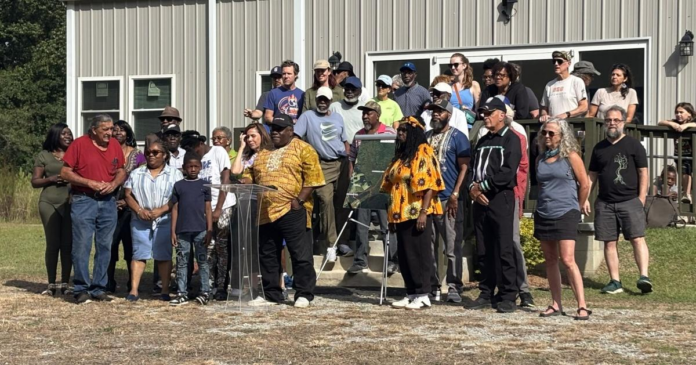BRITTONS NECK — Freedomland Community Forest, a 305-acre wetland forest in rural Marion County, was once the location of the Woodberry Plantation.
Now the land is in the hands of a community where some residents descended from the plantation’s enslaved people.
The Rev. Leo Woodberry, the executive director of conservation organization New Alpha Community Corp., has ancestors who were enslaved on Woodberry Plantation. He was instrumental in conserving the land and turning it into a community forest.
Conservation organizations New Alpha Community Development Corp. and Dogwood Alliance worked with some community leaders to secure funds for the property that was most recently used for industrial logging. The acquisition led to a Sept. 13 celebration and ribbon-cutting ceremony.
Sasha Mitchell is the operations director at Dogwood Alliance and a self-taught historian. When Woodberry asked her to do some digging on the site’s history, she found that part of the forest was once Woodberry Plantation.
“I look at it as divine providence because when we got an offer to purchase the land, we didn’t know that it used to be a plantation,” Woodberry said.
Woodberry remembers when Brittons Neck, a rural community of about 2,000, only had two paved roads and zero indoor plumbing. He has watched the community flourish since then, but he has also witnessed destruction.
He saw Hurricane Florence and Matthew, as well as the 1,000-year flood in 2015, wreak havoc on Brittons Neck, causing some residents to evacuate their homes.
Woodberry said logging in the area’s dense woodlands didn’t help.
“It’s very important that we maintain our forests and our wetland because those are nature’s natural defense against flooding,” Woodberry said.
The logging, the flooding, the fear of disrupting threatened species and the negative impacts on Brittons Neck all led to the acquisition of Freedomland Community Forest.
The expansive property along the Little Pee Dee River is diverse, containing old-growth cypress swamps, five oxbow lakes and a mile of river frontage.
Danna Smith, executive director for Dogwood Alliance, said their goal is to work in harmony with communities such as Brittons Neck. Forest conservation and the impact of logging were concerns with the Brittons Neck community, according to Smith.
“I think the Brittons Neck forest is sort of a flashpoint, if you will, across the rural landscape of the South for a new vision for the forest economy of the South,” Smith said.
The idea is that ecotourism and outdoor recreation uses for forests are more beneficial to a community and contribute more to the local tax base than industrial uses, according to Smith.
The model being developed in the Freedomland Forest is called Justice Conservation. New Alpha and Dogwood Alliance aren’t content to stop at Brittons Neck. The goal is to use the model to protect forests and wetlands in other rural, southern communities that are being negatively impacted by industrial logging.
“We’re really at a crossroads right now in the Southern U.S., where we have a number of paper mills that are closing down and an opportunity to sort of rethink the forest economy in ways that create more balance where more forests are protected and our rural economies can become more diversified,” Smith said.
The acquisition of Freedomland Community Forest joins another wetland forest conservation purchase with the Pee Dee Tribe. Seventy-six acres of land were purchased for the tribe to hold meetings on.
There was once a time when the Pee Dee Tribe met on three acres of land in a double-wide trailer. Today, they meet on 91 acres of land with two buildings on the property, and they have future plans to create a living village to teach the community how the tribe once lived, according to Pee Dee Tribe Chief Pete Parr.
Having the increase in acreage has allowed the tribe more freedom and has allowed them to form more goals for the future, according to Parr. The tribe also cares for the land and protects the wetlands around them.
Smith and Woodberry both acknowledge the power behind the two of them working together for the restorative justice of land — Smith’s ancestors were once slave owners, and Woodberry’s were enslaved.
“I just think this is such a powerful positive story of how we can come together and be in good relationships, not just with each other, but also with the land,” Smith said. “Sometimes people think that this type of restorative justice is really scary, or it’s somehow hurtful to people whose ancestors have been a part of that legacy, but it doesn’t have to be that. I think that this project really demonstrates what it can be in a very hopeful and positive and loving way.”




